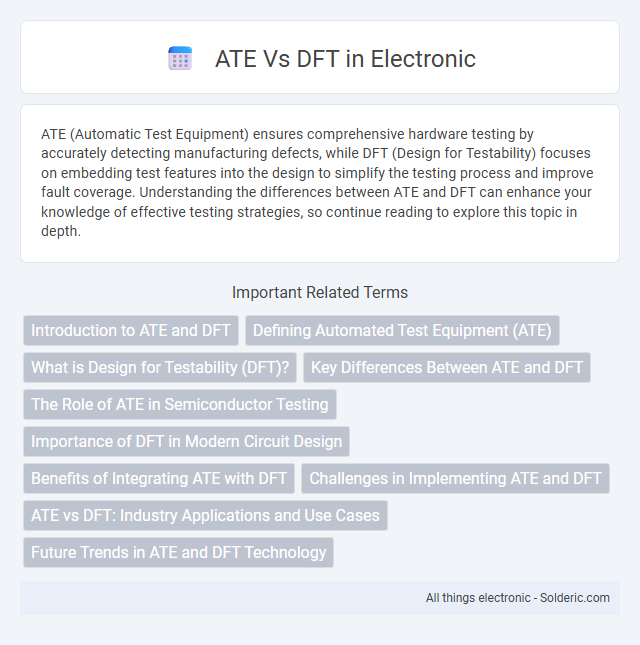ATE (Automatic Test Equipment) ensures comprehensive hardware testing by accurately detecting manufacturing defects, while DFT (Design for Testability) focuses on embedding test features into the design to simplify the testing process and improve fault coverage. Understanding the differences between ATE and DFT can enhance your knowledge of effective testing strategies, so continue reading to explore this topic in depth.
Comparison Table
| Aspect | ATE (Automatic Test Equipment) | DFT (Design for Testability) |
|---|---|---|
| Definition | Hardware setup for automated testing of electronic devices. | Design techniques to improve the testability of circuits. |
| Primary Purpose | Conduct fast, accurate testing and fault detection. | Facilitate easier and efficient testing during manufacturing. |
| Focus Area | Test execution and measurement. | Circuit design improvements like scan chains, built-in self-test. |
| Tools | Testers, analyzers, and hardware instruments. | Design methodologies and insertion tools. |
| Benefits | High throughput, precise fault coverage. | Reduced test time, improved fault detection during production. |
| Implementation Stage | Post-design, during production testing. | During design phase of circuits and systems. |
Introduction to ATE and DFT
Automated Test Equipment (ATE) and Design for Testability (DFT) are critical in semiconductor manufacturing and electronic testing. ATE involves hardware and software systems that automate the testing of integrated circuits to detect manufacturing defects efficiently. DFT integrates specific design techniques into the chip to enhance test coverage and simplify fault detection, ensuring your products undergo robust validation.
Defining Automated Test Equipment (ATE)
Automated Test Equipment (ATE) refers to specialized hardware and software systems designed to perform automated testing on electronic devices to ensure functionality, performance, and quality. ATE is crucial for accelerating production testing, reducing human error, and providing detailed diagnostics compared to manual testing methods. Your organization can leverage ATE to streamline the verification process, complementing Design for Testability (DFT) strategies aimed at simplifying internal test access.
What is Design for Testability (DFT)?
Design for Testability (DFT) is a methodology used in integrated circuit design to simplify and enhance the testing process by incorporating test features directly into the hardware. It enables efficient fault detection and diagnosis by facilitating easier access to internal nodes and reducing test time and cost compared to Automated Test Equipment (ATE) alone. Your ability to identify defects and ensure product reliability significantly improves with DFT techniques such as scan chains and built-in self-test (BIST).
Key Differences Between ATE and DFT
ATE (Automated Test Equipment) physically tests semiconductor devices to detect manufacturing defects through electrical signals, while DFT (Design for Testability) integrates test features into the design phase to facilitate easier and more effective testing. ATE operates at the final production stage, providing high-speed, automated testing of chips, whereas DFT improves test coverage and reduces test time by enabling built-in self-test (BIST) and scan chain techniques. Understanding these key differences helps optimize Your testing strategy for both cost-efficiency and fault detection accuracy.
The Role of ATE in Semiconductor Testing
Automated Test Equipment (ATE) plays a crucial role in semiconductor testing by providing high-speed, precise evaluation of integrated circuits to ensure functionality and detect defects. ATE systems enable comprehensive testing of chips through electrical stimuli and response analysis, significantly improving yield and reliability. Your production process relies on ATE to efficiently validate semiconductor performance, complementing Design for Testability (DFT) strategies implemented during chip design.
Importance of DFT in Modern Circuit Design
Design for Testability (DFT) is crucial in modern circuit design as it integrates test features directly into the hardware, enabling efficient fault detection and diagnosis. Unlike Automated Test Equipment (ATE) that relies on external testing, DFT enhances test coverage and reduces production costs by simplifying fault isolation. Implementing robust DFT strategies ensures your circuits meet quality standards and accelerates time-to-market through streamlined testing processes.
Benefits of Integrating ATE with DFT
Integrating Automatic Test Equipment (ATE) with Design for Testability (DFT) enhances fault coverage by enabling more accurate and efficient testing of complex semiconductor devices, reducing manufacturing defects and improving yield. This integration facilitates faster test development and execution, lowering overall production costs and time-to-market for integrated circuits. Enhanced diagnostic capabilities provided by this combination improve failure analysis and reliability assessments, driving higher product quality and customer satisfaction.
Challenges in Implementing ATE and DFT
Implementing Automated Test Equipment (ATE) involves challenges such as high initial costs, complex setup procedures, and the need for specialized expertise to manage hardware and software integration. Design for Testability (DFT) faces difficulties in balancing test coverage with design complexity, ensuring minimal impact on performance and power consumption while embedding test structures. Your successful testing strategy requires addressing these challenges by optimizing resource allocation and leveraging advanced tools to enhance fault detection and diagnosis.
ATE vs DFT: Industry Applications and Use Cases
Automatic Test Equipment (ATE) is extensively used in semiconductor manufacturing for final testing and quality assurance, ensuring device functionality and reliability through high-volume production testing. Design for Testability (DFT) techniques are integrated during IC design to facilitate easier and more effective testing, enabling fault detection and diagnosis at the design stage, which is critical in aerospace and automotive industries for safety-critical systems. Semiconductor companies leverage ATE for production test environments while utilizing DFT methodologies to reduce test costs and improve test coverage during the design phase.
Future Trends in ATE and DFT Technology
Future trends in Automatic Test Equipment (ATE) and Design for Testability (DFT) technology emphasize increased integration of AI and machine learning to enhance fault detection and predictive maintenance. Advanced test algorithms and real-time data analytics improve test accuracy while reducing cycle times and costs. Your organization can leverage these innovations to optimize testing workflows and accelerate time-to-market for complex semiconductor devices.
ATE vs DFT Infographic

 solderic.com
solderic.com